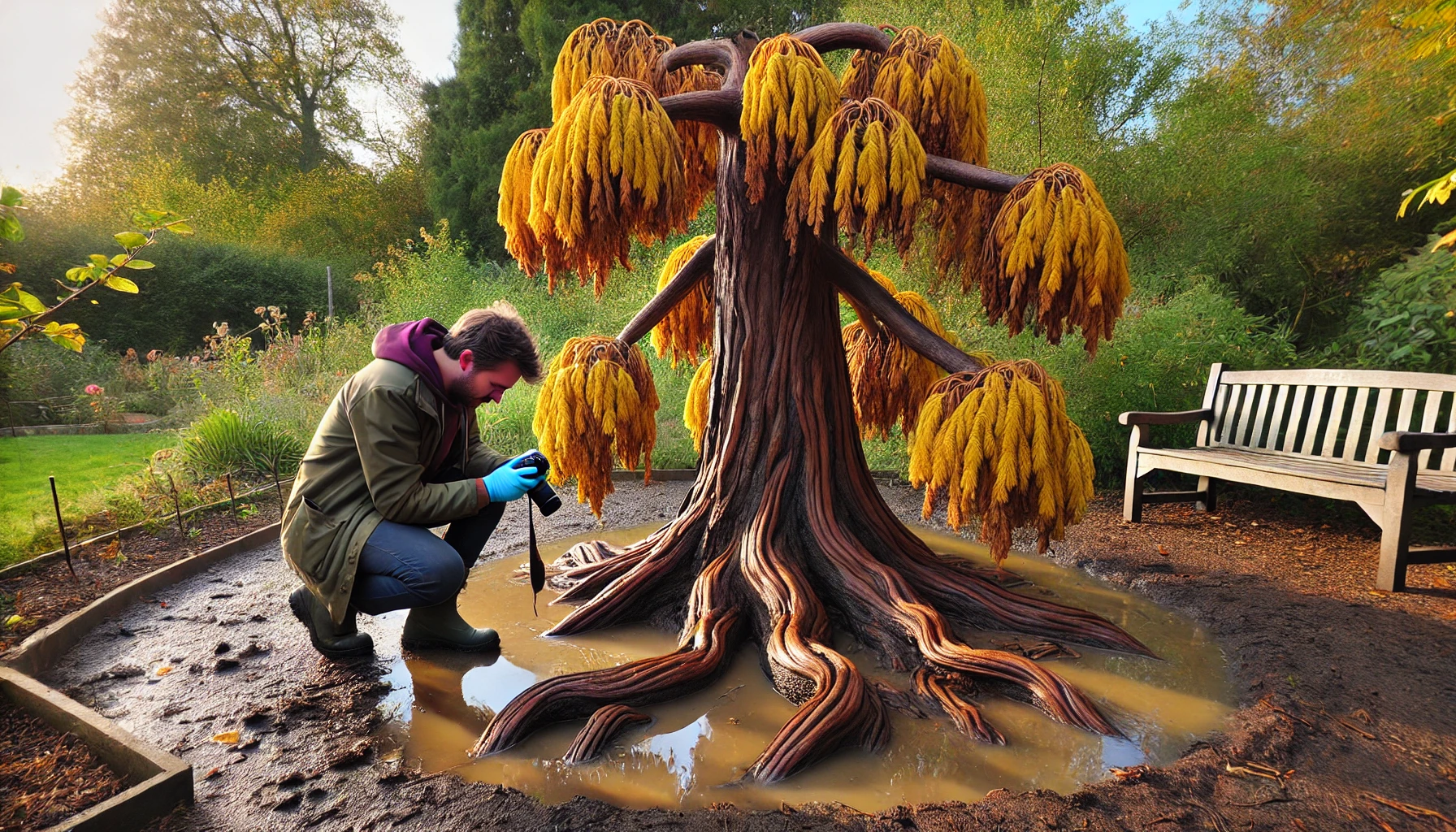
How to Grow and Care for a Weeping Giant Sequoia: A Complete Guide for Homeowners
Imagine having a majestic, towering tree in your garden that stands out with its unique, cascading branches—this is the beauty of the weeping giant sequoia. 
Whether you’re a seasoned gardener or a first-time homeowner, knowing how to properly plant and maintain a weeping giant sequoia is key to ensuring its health and growth. In this guide, we’ll walk you through everything you need to know— from choosing the right location to pruning and caring for this magnificent tree. By the end, you’ll have all the tools to nurture a thriving weeping giant sequoia in your own yard. 
Table of Contents
ToggleWhat is a Weeping Giant Sequoia? 
The Weeping Giant Sequoia is a unique and stunning variation of the famous Sequoia tree, known for its graceful, drooping branches and lush, needle-like foliage. This tree is a natural beauty, combining the iconic size and strength of the Giant Sequoia with a softer, more elegant appearance. It’s perfect for homeowners looking to add a touch of nature’s grandeur with a bit of whimsy.
Unlike regular Sequoias that grow straight and tall, the Weeping Giant Sequoia has branches that cascade downward, creating a weeping effect. This distinctive trait gives the tree a more dramatic and enchanting look, making it a standout in gardens and landscapes.

Despite its elegance, it shares many characteristics with the regular Giant Sequoia, such as its incredible size (reaching up to 50–60 feet in height), durability, and longevity. With the right care, this tree can thrive for generations, becoming a long-lasting and awe-inspiring addition to your outdoor space.
Key Features:
- Drooping branches that create a weeping effect
- Lush green needles that stay vibrant year-round
- Massive size—it can reach up to 60 feet tall in the right conditions
- Hardiness in a variety of climates, making it adaptable for many homeowners
Whether you’re planting a small garden or looking to add drama to a larger landscape, the Weeping Giant Sequoia offers a striking visual that’s hard to miss.
Ideal Growing Conditions for a Weeping Giant Sequoia 
Growing a Weeping Giant Sequoia is a rewarding experience, but ensuring that you provide the ideal conditions is key to its health and longevity. These magnificent trees can thrive in the right environment, so let’s break down the best growing conditions you need to keep your sequoia happy and growing strong.
1. Location: Choose the Right Spot 
Weeping Giant Sequoias love plenty of space and sunlight. Plant your tree in an area that gets full sun for most of the day (at least 6 hours of direct sunlight). These trees can tolerate some shade, but to reach their full potential, they need to bask in the sun’s warmth.
Also, ensure the space is large enough—these trees can grow massive, so think ahead about the room they’ll need to spread their branches!
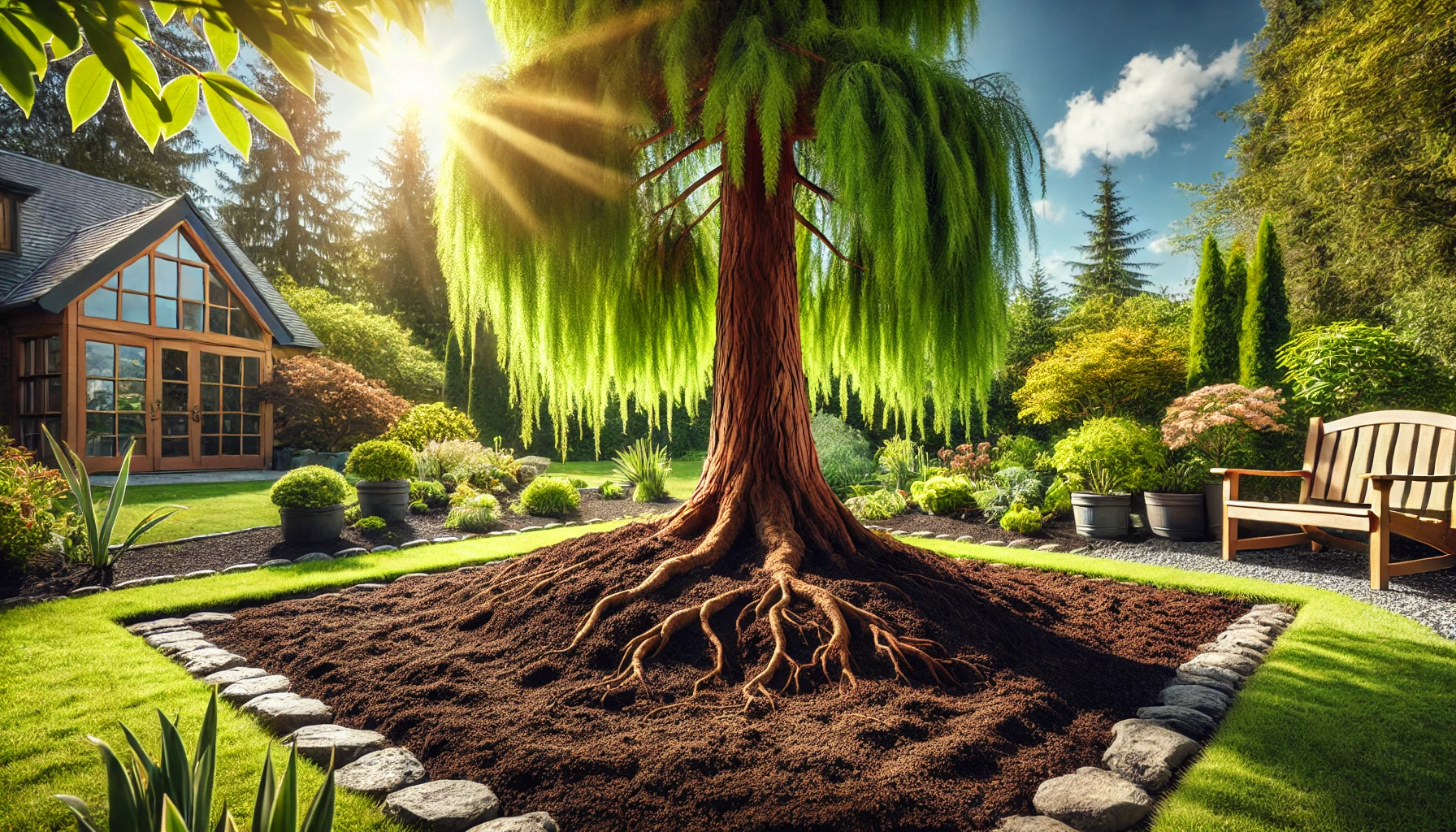
2. Soil: Well-Drained and Moist 
The soil for your Weeping Giant Sequoia should be well-draining but moist. These trees thrive in soil that retains some moisture without becoming waterlogged. If your soil is heavy clay, consider amending it with compost to improve drainage. Avoid planting in areas where water collects, as this can lead to root rot.
Ideal soil pH is slightly acidic to neutral, between 6.0 and 7.5. You can test your soil’s pH and make adjustments as needed.
3. Watering: Keep it Consistent 
Weeping Giant Sequoias enjoy consistent moisture, especially during their early growth years. Water deeply once or twice a week, depending on the weather and soil conditions. In hot or dry climates, you may need to water more frequently.
Remember, deep watering is better than frequent shallow watering. Allow the soil to dry out slightly between waterings, but never let it become bone dry for extended periods. A mulch layer around the base of the tree helps retain moisture and keeps the roots cool.
4. Temperature: Cool and Moderate 
These majestic trees naturally grow in cooler, temperate regions, so they prefer moderate temperatures. They can tolerate winter cold, but they are less happy in extreme heat or intense drought conditions. Ideally, temperatures should range between 50°F and 75°F (10°C to 24°C).
In areas with very hot summers, consider planting your sequoia where it will get some afternoon shade to protect it from the heat.
5. Wind Protection: A Sheltered Spot 
Although tough, a Weeping Giant Sequoia can be vulnerable to strong winds, especially when it’s young. Choose a spot that offers some wind protection—such as near a building or fence. If you live in an area with high winds, consider installing a windbreak or planting your tree in a sheltered spot to prevent damage to the delicate branches.
6. Space to Grow: Think Big 
As these trees grow, they can become quite large. Make sure to plant your Weeping Giant Sequoia in a spot with enough room to accommodate its future size. Overcrowding can stunt its growth and affect its health. Ideally, leave about 15-20 feet between the tree and other plants or structures to allow it to spread freely.
7. Fertilization: Feed Sparingly 
Weeping Giant Sequoias don’t need a lot of fertilizer. In fact, too much can harm the tree! It’s best to fertilize lightly once a year in early spring with a slow-release fertilizer that’s balanced in nitrogen, phosphorus, and potassium. Over-fertilizing can lead to weak growth and other issues. Keep it simple and organic when you can!
8. Protection from Pests and Diseases 

While Weeping Giant Sequoias are generally hardy, they can be susceptible to a few pests like aphids, scale, or spider mites. Keep an eye out for signs of pests and treat them with an eco-friendly insecticidal soap or horticultural oil if necessary. Regularly check for signs of disease, like discoloration or wilting, to catch problems early.
By following these simple guidelines, your Weeping Giant Sequoia will have the ideal growing conditions it needs to thrive and impress. 
Planting Your Weeping Giant Sequoia 
Planting a Weeping Giant Sequoia in your yard can be a rewarding and awe-inspiring experience. These majestic trees, known for their sweeping branches and striking beauty, make a stunning addition to any landscape. However, getting them off to a great start is essential for long-term growth. Here’s a simple, step-by-step guide to help you plant your Weeping Giant Sequoia successfully.
1. Choose the Right Location 
Weeping Giant Sequoias thrive in full sunlight, so pick a spot that receives at least 6-8 hours of direct sun each day. Ensure the area has well-draining soil—these trees don’t like “wet feet.” Avoid places where water tends to pool after rain, as this could lead to root rot. Also, keep in mind that these trees can grow large and wide, so give them plenty of space to spread out!
2. Prepare the Soil 
Before planting, loosen the soil in a wide area (about 3 feet in diameter). If your soil is heavy clay, mix in some organic compost or sand to improve drainage. A slightly acidic to neutral pH (6.0-7.5) is ideal. This will give your sequoia the best foundation to establish strong roots.
3. Dig a Planting Hole 
Dig a hole that’s about twice as wide and just as deep as the root ball of your tree. You want the roots to have plenty of room to expand but avoid planting the tree too deep—its base should be level with the surrounding soil. Gently remove the tree from its pot, being careful not to disturb the roots.
4. Plant Your Tree 
Place your Weeping Giant Sequoia in the center of the hole and fill in the gaps with soil, pressing it gently to eliminate air pockets. Be sure the root collar (where the roots meet the trunk) is just at or slightly above the soil level. If the soil settles after watering, top it off to maintain the correct level.
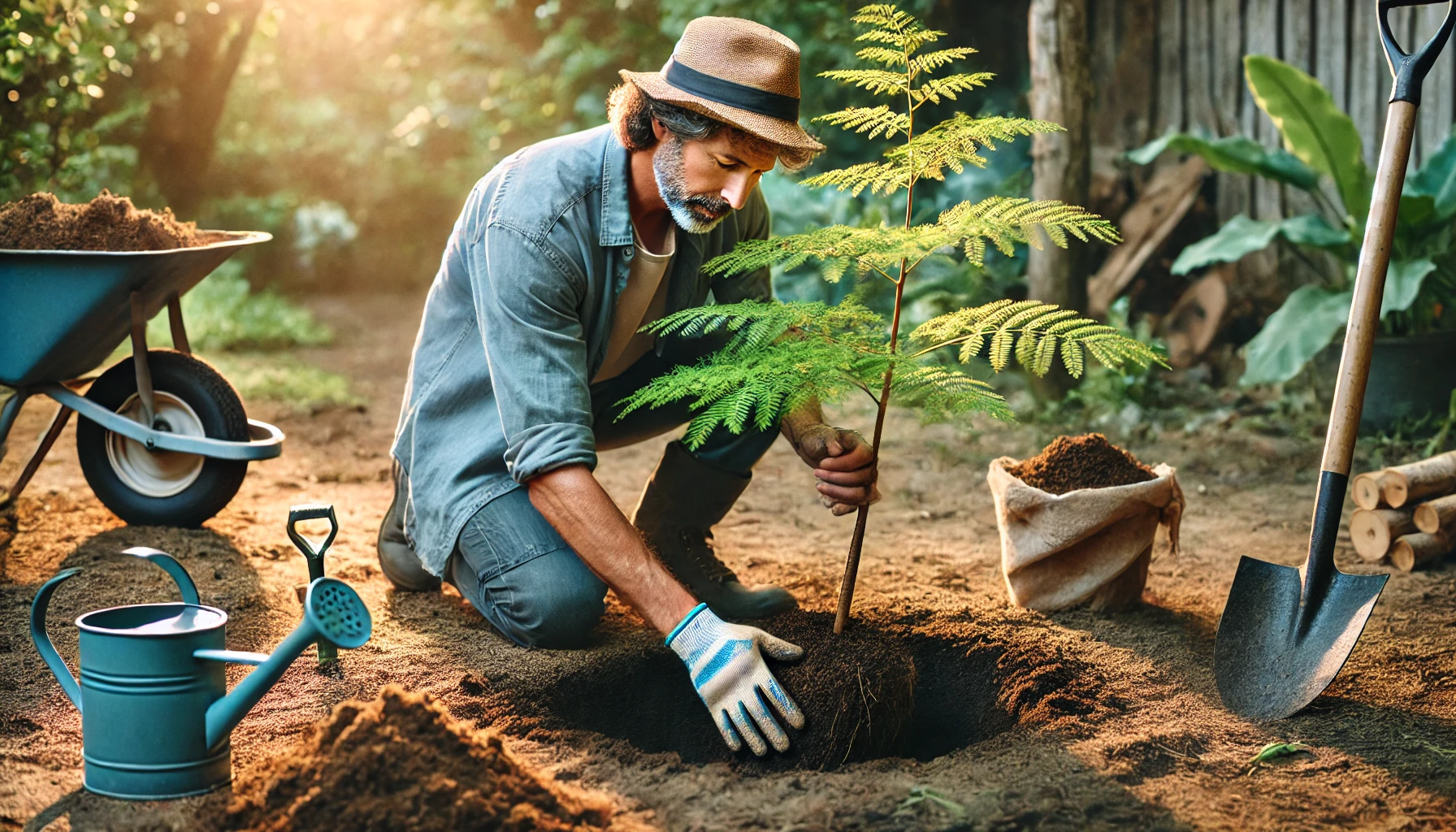
5. Water Generously 
After planting, water your tree deeply. Weeping Giant Sequoias love moisture, especially during the first year of growth. Make sure the soil is consistently moist but not waterlogged. Mulch around the base of the tree (3-4 inches deep) to help retain moisture and keep the roots cool.
6. Monitor for Growth 
In the first few months, check your tree regularly for signs of stress. If the soil begins to dry out, increase watering. However, avoid overwatering, as soggy soil can lead to root problems. As the tree establishes itself, you can gradually reduce the frequency of watering.
7. Add Fertilizer (Optional) 
Fertilizing is not mandatory, but it can help encourage growth. Use a balanced, slow-release fertilizer in early spring and again in early summer, following package instructions. Avoid fertilizing too late in the growing season, as this can encourage late-season growth that may not harden off before winter.
By following these simple planting tips, your Weeping Giant Sequoia will have the best start possible. 

Ongoing Care and Maintenance 
Caring for your Weeping Giant Sequoia doesn’t end once it’s planted! To keep your tree healthy and thriving, follow these easy and practical tips for ongoing care and maintenance. By staying on top of a few key tasks, you’ll ensure your Sequoia grows strong and continues to be a stunning focal point in your garden.
1. Watering 
Weeping Giant Sequoias need consistent moisture, especially when young. Water deeply once a week during dry periods, ensuring the water reaches the roots. Avoid shallow watering, as it can encourage shallow root growth. 
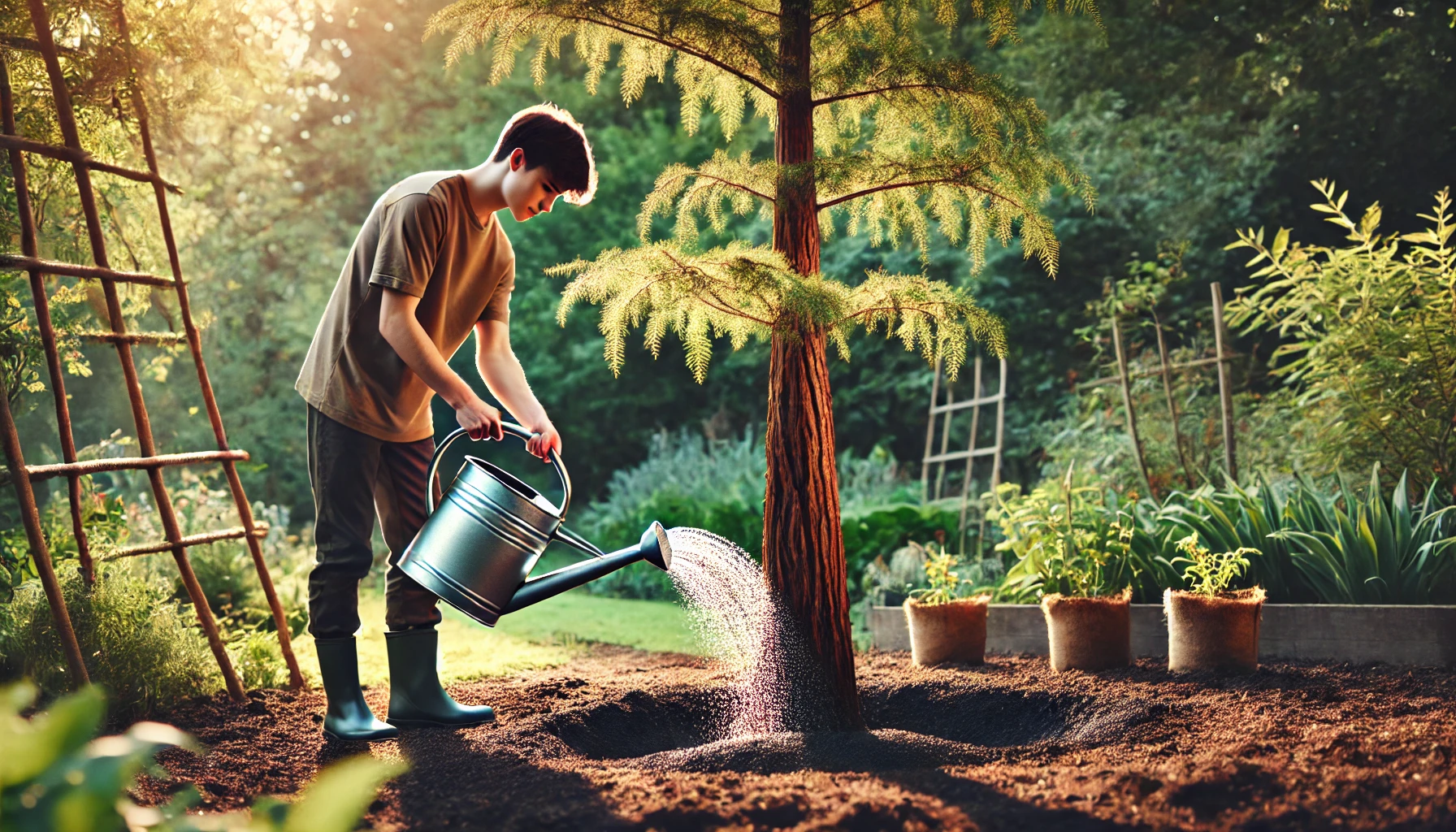
2. Mulching 
Mulch is your best friend! Applying a layer of mulch (around 3–4 inches) around the base of your tree helps retain moisture, prevent weeds, and maintain even soil temperature. Organic mulches, like wood chips or bark, work best. Just make sure to keep the mulch a few inches away from the trunk to prevent rot.
3. Pruning 
Pruning your Sequoia is optional but can help maintain its shape. Remove any dead, damaged, or crossing branches to encourage healthy growth. Focus on pruning during late winter or early spring when the tree is dormant. 
4. Fertilizing 
While Sequoias are fairly low-maintenance when it comes to fertilization, providing them with a slow-release, balanced fertilizer once in early spring can boost their growth, especially in nutrient-poor soils. Be careful not to over-fertilize, as this can damage the roots.
5. Pest and Disease Management 

Though Weeping Giant Sequoias are generally resistant to pests and diseases, keep an eye out for common tree issues like aphids, spider mites, or fungal infections. 
6. Protecting from the Elements 

Giant Sequoias are hardy, but young trees may need a little extra protection during extreme weather. Consider wrapping your tree in burlap during the harsh winter months or providing shade during intense summer heat. This will help reduce stress on the tree and allow it to thrive.
7. Monitoring Growth 

As your Sequoia matures, monitor its growth regularly. If you’re planting it near structures or other plants, make sure it has enough space to spread out. These trees can grow very tall, so be mindful of potential obstacles like power lines or buildings as it matures.
By staying consistent with watering, mulching, pruning, and monitoring its overall health, you’ll ensure your Weeping Giant Sequoia remains a gorgeous, long-lasting addition to your yard. 
Happy gardening!
Managing Pests and Diseases 

Weeping Giant Sequoias are relatively low-maintenance trees, but like any plant, they can be susceptible to pests and diseases. Knowing how to spot and manage these issues early on will help your tree stay healthy and vibrant. Here are the most common pests and diseases that affect Weeping Giant Sequoias and how to deal with them:
1. Aphids 
Aphids are tiny, soft-bodied insects that suck the sap from your tree’s leaves and stems. This can cause the leaves to curl, yellow, and drop prematurely. You might also notice a sticky residue (honeydew) on the branches or surrounding surfaces.
How to Manage Aphids:
- Prune affected branches: If you notice an infestation, trim the affected parts of the tree.
- Wash them off: A strong blast of water from a hose can dislodge aphids.
- Use insecticidal soap: If the infestation is heavy, applying insecticidal soap can help control the population.
2. Spider Mites 
Spider mites are tiny arachnids that thrive in hot, dry conditions. They feed on the underside of leaves, causing them to develop a speckled appearance. In severe cases, spider mites can cause leaves to turn yellow and fall off.
How to Manage Spider Mites:
- Increase humidity: Mites prefer dry environments, so increasing the moisture around your tree can discourage them.
- Neem oil: Apply neem oil to the affected areas to kill spider mites and prevent further damage.
- Rinse the tree: Regularly hose down the leaves to wash away spider mites.
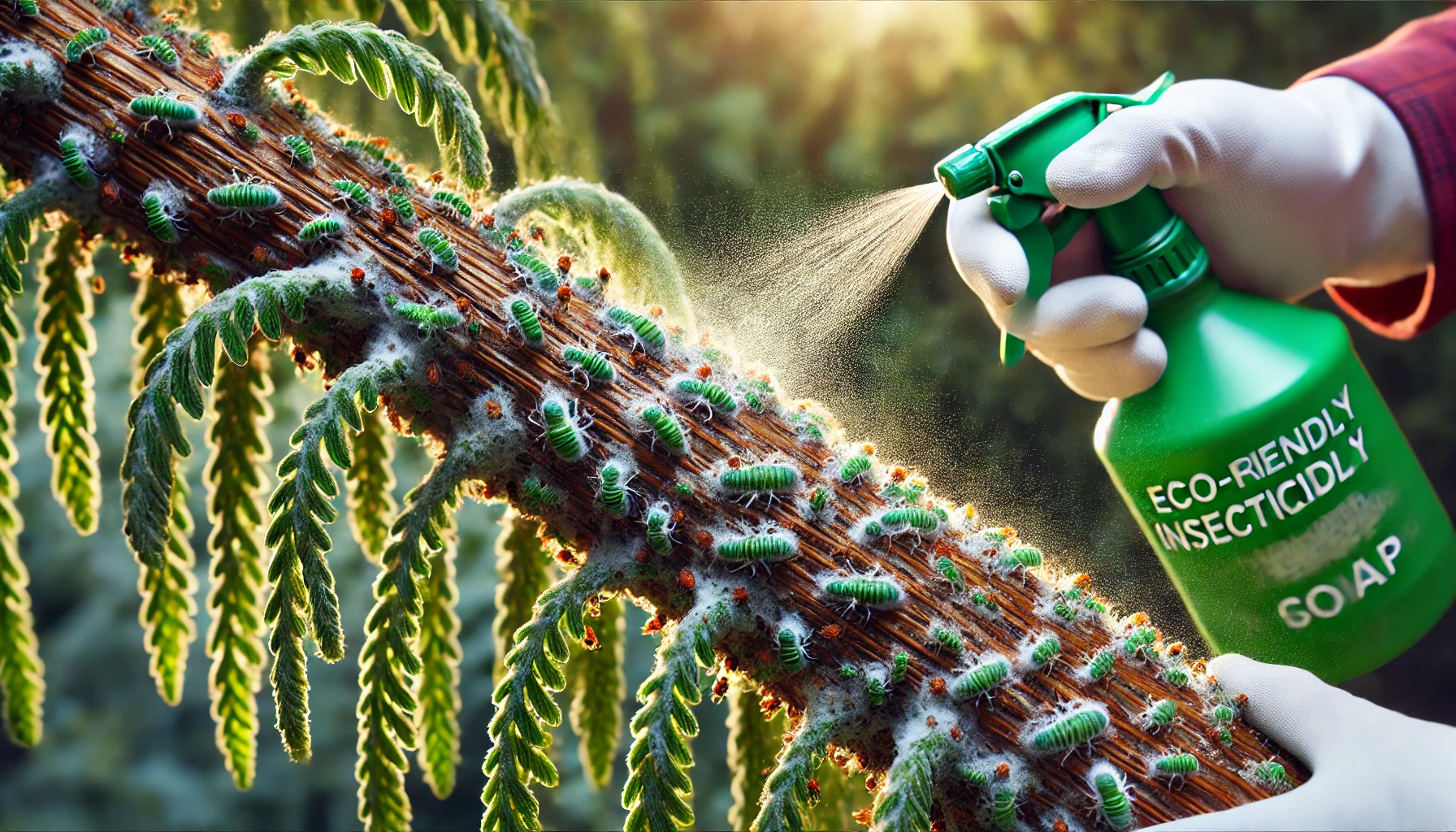
3. Scale Insects 
Scale insects are small, hard-shelled pests that attach themselves to the bark and branches of trees. They suck out the sap, which weakens the tree and can lead to stunted growth or branch dieback.
How to Manage Scale Insects:
- Prune infected branches: Remove heavily infested branches to prevent the spread of the pests.
- Apply horticultural oil: Spray the tree with dormant or horticultural oil during the winter when the scales are in their juvenile stage.
- Manual removal: For smaller infestations, you can remove scales by gently scraping them off with a soft brush.
4. Root Rot 
Root rot, often caused by fungal infections, occurs when the roots of your Sequoia tree are waterlogged or exposed to poor-draining soil. The fungus infects the roots, leading to yellowing leaves, stunted growth, and eventually tree death.
How to Prevent and Manage Root Rot:
- Ensure good drainage: Make sure your tree is planted in well-draining soil. Consider adding sand or organic matter to improve drainage.
- Avoid overwatering: Water your tree only when the soil feels dry to the touch. This helps prevent the roots from sitting in stagnant water.
- Remove infected roots: If you notice root rot, carefully prune the affected roots and repot or relocate the tree to a better-drained area.
5. Rust Fungi 
Rust fungi can cause orange or yellow spots on your tree’s leaves. This disease is typically spread by wind or rain, and while it doesn’t usually kill the tree, it can make the foliage unsightly and weaken the tree.
How to Manage Rust Fungi:
- Prune affected leaves: Remove infected leaves and discard them to prevent the spread of the fungus.
- Increase air circulation: Plant your Sequoia in a location that allows for good air circulation, as rust thrives in damp, crowded conditions.
- Apply fungicide: If rust becomes a recurring problem, consider using a fungicide to protect the tree.
6. Bagworms 
Bagworms are larvae that live in protective, bag-like cases and can defoliate your tree if left unchecked. They attach to the branches and feast on the leaves, which can lead to unsightly damage.
How to Manage Bagworms:
- Hand-pick the bags: If you spot a few bagworms, you can easily remove them by hand and destroy them.
- Insecticidal spray: For larger infestations, spraying insecticidal soap or neem oil can kill the larvae inside the bags.
- Introduce natural predators: Birds and parasitic wasps can help control bagworm populations naturally.
7. Powdery Mildew 
Powdery mildew is a fungal infection that forms a white, powdery coating on the leaves and stems of your tree. While it’s not usually fatal, it can stunt the tree’s growth and cause cosmetic damage.
How to Manage Powdery Mildew:
- Prune affected branches: Remove any infected leaves or stems to stop the spread of the fungus.
- Increase airflow: Prune around the base of the tree to improve airflow, as powdery mildew thrives in humid, stagnant conditions.
- Fungicide application: If mildew is persistent, apply a fungicide to control the spread.
General Tips for Pest and Disease Prevention 
- Regularly inspect your tree: Check your Sequoia every few weeks for signs of pests or disease.
- Provide proper care: Healthy trees are less likely to be attacked by pests or diseases, so ensure your Sequoia is planted in the right soil, receives adequate water, and gets enough sunlight.
- Clean up fallen debris: Fallen leaves, needles, and branches can harbor pests or fungal spores, so clean up regularly to minimize the risk.
By keeping an eye on your Weeping Giant Sequoia and taking proactive measures, you can prevent many common pests and diseases. With the right care, your tree will thrive and bring beauty to your landscape for years to come!
Troubleshooting Common Problems with Weeping Giant Sequoia 
Growing a Weeping Giant Sequoia can be a rewarding experience, but like any tree, it can face a few challenges. Here are some common problems you might encounter and how to solve them.
1. Yellowing Leaves 
Yellow leaves are a sign that something isn’t quite right with your sequoia. This issue can be caused by several factors:
- Overwatering: Giant Sequoias like their soil to be moist but not soggy. If the soil is too wet, it can lead to root rot, which causes yellowing. Make sure your tree is planted in well-draining soil.
- Nutrient Deficiency: Yellowing could also point to a lack of essential nutrients, especially nitrogen. Consider feeding your tree with a balanced fertilizer to promote healthy growth.

2. Brown or Crispy Leaves 
If the leaves on your Weeping Giant Sequoia are turning brown or crispy, it could be due to:
- Underwatering: If the soil is too dry for an extended period, the leaves may dry out. Ensure the tree receives regular watering, especially during dry spells.
- Heat Stress: These trees prefer cooler, more humid climates. Prolonged exposure to intense heat can cause leaf burn. Try to provide some shade during the hottest part of the day, especially in warmer climates.

3. Pests and Insects 
Although the Weeping Giant Sequoia is generally pest-resistant, it can occasionally fall prey to insects like aphids or spider mites. Signs of pest infestations include:
- Sticky residue on leaves.
- Tiny, discolored spots on the foliage.
- Visible insects on the tree.

4. Wilting or Drooping Leaves 
Wilting leaves may indicate a problem with your tree’s root system or environment:
- Root Rot: Caused by overwatering, root rot weakens the tree and prevents it from absorbing nutrients. If the tree is potted, check the drainage holes. In ground-planted trees, ensure there’s no water pooling around the roots.
- Poor Soil Drainage: If the soil doesn’t drain well, water can become trapped around the roots, suffocating them. Try adding organic matter or compost to improve drainage.

5. Slow Growth 
If your Weeping Giant Sequoia isn’t growing as quickly as you’d like, it could be due to:
- Lack of Sunlight: These trees need plenty of sunlight to thrive. Make sure your tree is getting at least 6 hours of direct sunlight per day.
- Soil Compaction: Soil that is too compact can restrict root growth and water penetration. Aerate the soil around the tree to encourage healthy root development.

6. Tree Not Tolerating Winter Temperatures 
While Giant Sequoias are cold-tolerant, extreme winter conditions can still stress the tree. If you live in a colder region, you might notice:
- Damage to Foliage: Frost can damage young or vulnerable leaves. If you’re expecting a particularly harsh winter, consider covering your tree with a frost cloth or burlap to protect it.
- Roots Freezing: In severe winter conditions, the soil around the roots might freeze. Adding a thick layer of mulch around the base can help insulate the roots.

By staying proactive and addressing these issues early, your Weeping Giant Sequoia will thrive and grow into a majestic tree. 
Conclusion
Growing and caring for a weeping giant sequoia is a truly rewarding experience that can transform any outdoor space into a stunning landscape. By following the steps outlined in this guide—from planting and choosing the perfect location to proper care and troubleshooting—you’re well on your way to cultivating a healthy, thriving tree that will be the focal point of your garden.
Remember, the weeping giant sequoia may require patience and dedication, but the results are absolutely worth it. With the right care, it will flourish and grow, providing beauty, shade, and a sense of tranquility for years to come.

Whether you’re a first-time gardener or an experienced homeowner looking to enhance your outdoor space, growing a weeping giant sequoia offers long-term rewards that are hard to match. Start planting today, and let your garden shine with the timeless beauty of this incredible tree!
Frequently Asked Questions(FAQ)
How fast does a weeping giant sequoia grow?
The weeping giant sequoia grows at a moderate pace, typically around 1-2 feet per year. However, this can vary depending on growing conditions such as sunlight, soil quality, and water availability.
Can I plant a weeping giant sequoia in a small yard?
While a weeping giant sequoia can be planted in smaller yards, it requires ample space to grow. Make sure there is enough room for its width and height at maturity. Regular pruning can help manage its size, but it still needs plenty of space to thrive.
What type of soil is best for a weeping giant sequoia?
Weeping giant sequoias prefer well-drained, slightly acidic soil. A good soil mix that retains moisture but doesn’t get waterlogged is ideal. You can improve soil drainage by adding organic matter like compost.
How much sunlight does a weeping giant sequoia need?
The weeping giant sequoia thrives in full sun, meaning it needs at least 6 hours of direct sunlight daily. However, it can tolerate partial shade, especially in hotter climates, though its growth may be slower.
How often should I water my weeping giant sequoia?
Water your weeping giant sequoia regularly, especially in the first few years of growth. The soil should be kept consistently moist but not soggy. During dry spells, you may need to water more frequently, but be sure the soil drains well to prevent root rot.
Do weeping giant sequoias need to be pruned?
Yes, pruning is necessary to maintain the tree’s shape and remove dead or damaged branches. Prune in early spring or late winter to encourage healthy growth. Regular pruning can also help manage its size and prevent it from becoming too leggy.
What are the common pests or diseases that affect weeping giant sequoias?
Weeping giant sequoias are generally resistant to many pests and diseases but can still be affected by aphids, scale insects, or fungal infections. Regularly inspect the tree for signs of pests or yellowing leaves, and treat with organic insecticides if needed.
How long does a weeping giant sequoia live?
Weeping giant sequoias, like their towering relatives, can live for hundreds of years. With proper care, your tree can thrive for many decades, becoming a beautiful and lasting addition to your landscape.






